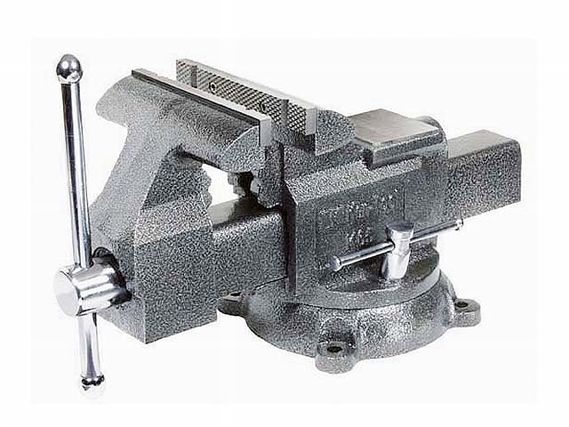 | Ken-Tool Professional Workshop Vise
| Ken-Tool Professional Workshop Vise
When you work on cars, sometimes you have to find a way to secure large or small assemblies or parts while wrenching on them, tinkering with them or even while cleaning, sanding or painting them. You won't have to look very long around any professional auto shop before you spy a bench vise, perhaps several of them. Hang around, and you'll see them used again and again throughout the workday. I'm not saying you need to have a vise to work on a car that's clearly not the case. But it will make your life a great deal easier. You won't, for example, have to have your wife stand on a MacPherson strut housing while you torque down the collar nut on a new shock insert and think about maybe how all those bon-bons and Dove Bars might not be such bad things after all.
For example, say your driveshaft is flip-flopping around under the car like a presidential candidate. It needs to be completely refurbished. Worst-case scenario: The car is a BMW 2500 "Bavaria" that has to take you cross country in 3 days. It has a two-piece driveshaft with a center bearing assembly, universal joints staked in place instead of fixed with normal circlips, and the entire festered mess has not been out of the car since the candidate made his first flip, when you were a mere figment in your parents' delusions in '69. You've already wrestled a Midas one-size-fits-none exhaust system out of the poor car, and you've got rust in parts of the car's body you didn't even know it had. Worse, you ruined that no-longer-available exhaust bracket from the gearbox to the downpipe, and now you'll have to fabricate something.
And there's no more beer on Sunday night in Dingledorf, Penn.; there's no place left open to buy more. And on the shop TV, the Speed Channel just preempted 3 Series privateers kicking touring car ass in favor of a 2-hour advertising special, NASCAR Drivers of Yesteryear: The Bobblehead Collection.
Now, in this frame of mind, how are you going to hold that driveshaft while you work on the big nut that holds the two sections together? How you are going to hold that driveshaft while you spend the next 6 hours replacing the worst-Bavarian-idea-since-Hitler staked-in-place universal joints? You're going to put the thing in your bench vise, that's how!
Other, less dramatic uses range from installing wheel bearing races in a hub to holding a screwdriver while you make a "special tool" out of it. A vise can also be used as an anvil, for hammering and shaping metal. It can be used in place of a small hydraulic press, as in when you need to replace BMW alternator mount bushings. In that case, you can use long sockets as drifts. Most vises also have "pipe jaws," which can be used for various plumbing projects around the house or shop.
Vises can never be too big, as I learned years ago using my friend Vince Lispi's prized possession, a 175-lb railroad vise. The thing is massive. Its jaws will blithely swallow a Mercedes gearbox while you reseal the damn thing for the first time since some guy named Gerhard torqued it together after a lunch of brat and pilsner in the same year General Motors first considered fuel injection. This vise's power is incredible; you can easily use it as a hydraulic press, although Lispi has one of those, too. It is about 100 years old, and it has never broken to our knowledge. Until a humongous pressure-treated wood workbench was built for it, this vise was stronger than anything it was mounted to. If you could find one, something like this would run a good $1,000--used.
Bottom line: You can always put small stuff in a big vise, but not the other way around. They are like car batteries. Buy a lot more than you think you'll need, and chances are someday it will be just enough. There are all kinds of cheap-ass vises out there. You can buy one for $29.95 at Home Depot. They have their purpose and may suit the occasional household need. But if you're working on cars in the garage behind your house, I think you should plan on spending $100 to $200 for a quality shop vise.
We had a look at the Ken-Tool K-65 Professional Workshop vise, part number 64065. This 41-lb unit is made of heat-treated carbon steel, with V-notched reversible jaws that are smooth on one side, diamond cut on the other. The jaws are 6.5-in. wide and open to 7.5 in. Depth is 3 1/2 in. The base will swivel 360 degrees and uses positive lock-down bolts. Sold by Pelican Parts for $135.25, the Ken-Tool K-65 won't swallow a Mercedes gearbox, but it is what you should consider a minimum standard for automotive shop use.
